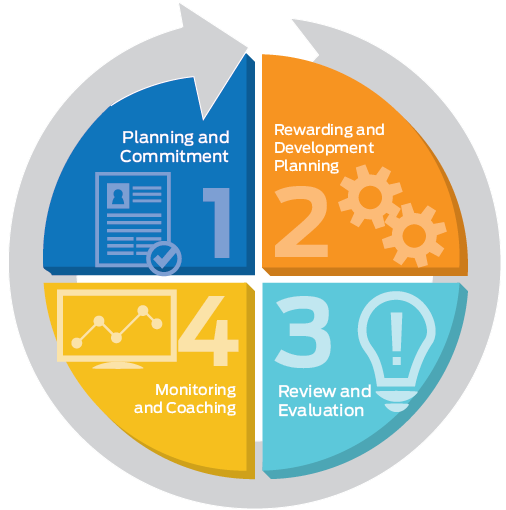ABOUT THE SPMS
Starting 2015, NEDA will adopt the Strategic Performance Management System (SPMS) as a tool for human resource and agency performance management.
The SPMS is meant to ensure that the agency’s goals and objectives are well defined in its strategic plan and to guide and encourage officials and employees to work as a team in achieving these objectives.
The SPMS improves upon the Performance Evaluation System (PES), which uses the “PERF” tool in rating employee performance. Table compares the PES and SPMS in terms of perspective, focus, indicators, performance alignment and the role of the supervisor.
Table 1. Comparison between the PES and SPMS
PES |
SPMS |
|
| Perspective | Performance evaluation | Performance management
|
| Focus | Activities and inputs
|
Outputs and outcomes
|
| Indicators | Performance indicators
|
Success indicators
|
| Performance alignment | Focus on individual
|
Align individual to Staff/NEDA
|
| Role of supervisor | Evaluator | Coach and mentor |
SPMS MONITORING AND MANAGEMENT
The NEDA-Performance Management Team (PMT) monitors and manages the overall implementation of the SPMS. It is headed by the DDG for Central Support Office and consists of Directors representing the four NEDA Offices.
The NEDA-PMT, together with the NEDA Management Committee (ManCom), ensures that performance targets and measures, as well as the budget, are aligned together and that work distribution of Offices and Staffs is rationalized.
The NEDA-PMT core secretariat is composed of the Human Resource Development Division (HRDD) of the Administrative Staff and the Corporate Planning and Monitoring Division (CPMD) of the Financial, Planning and Management Staff. The Development Information Staff (DIS) assists the NEDA-PMT in implementing the SPMS communication plan, while the Information and Communications Technology Staff (ICTS) provides technical support in developing an ICT-based monitoring system for the SPMS.
The Staff and NRO Directors are primarily responsible for performance management of their respective units, while the Division Chiefs under them assume joint responsibility in ensuring attainment of their unit’s performance objectives and targets. Individual employees act as partners of management and their co-employees in meeting organizational performance goals.
SPMS CYCLE AND TIMELINE
The SPMS cycle has four stages, shown in Figure 1 , implemented every semester:

 |
Stage 1—Planning and Commitment:
|
 |
Stage 2—Monitoring and Coaching:
|
 |
Stage 3—Review and Evaluation:
|
 |
Stage 4—Rewarding and Development Planning:
|
The prescribed timeline of SPMS Cycle implementation for 2015 is shown below.

STAGE 1: PLANNING AND COMMITMENT

What needs to be done at this stage?
- Identify and align performance goals
- Develop success indicators and rating scale
- Accomplish and review commitment forms
| B. Develop success indicators and rating scale | |||||||||||||||||||||||||||||||||||||||||||||||||||||||||||||||||||||||||||||||||||
| Step | What to produce? | What to consider? | Who’s responsible? | ||||||||||||||||||||||||||||||||||||||||||||||||||||||||||||||||||||||||||||||||
| 1.4 | Success indicators per output |
A success indicator should incorporate at least two of the three dimensions:
Indicators for each dimension should be SMART: specific, measurable, attainable, realistic, time-bound. Example of success indicator:
|
|||||||||||||||||||||||||||||||||||||||||||||||||||||||||||||||||||||||||||||||||
| 1.5 | Rating scale per dimension per output |
A. Quality of Work
| |||||||||||||||||||||||||||||||||||||||||||||||||||||||||||||||||||||||||||||||||
|
C. Accomplish and review commitment forms |
|||
| Step | What to produce? | What to consider? | Who’s responsible? |
| 1.6 | SPMS Form 1: Agency Performance Commitment and Review (APCR) | The APCR integrates the NEDA Physical and Financial Plan (NPFP) and NEDA Planning Tool, as well as the success indicators of the outputs (i.e., MFOs, budget, Office/Staff/NRO accountable). It is validated and evaluated by the MANCOM in terms of commitments and success indicators; and approved by the DG.
Columns under “Actual Accomplishments” and “Rating” will be left blank. |
NEDA MANCOM |
| 1.7 | SPMS Form 2: Office Performance Commitment and Review (OPCR) |
The OPCR form integrates the success indicators and Staff/NRO’s WFP (i.e., MFOs, budget and division accountable). It is committed by the Staff/NRO Director; reviewed by the FPMS and concerned Office representative; validated and evaluated by the supervising DDGs and ADGs in terms of commitments and success indicators; and approved by the DG. Columns under “Actual Accomplishments” and “Rating” will be left blank. The OPCR form will likewise integrate additional individual performance commitments of the Staff/NRO Directors and Assistant Directors. |
DG, DDGs, ADGs, Directors, Assistant Directors FPMS |
| 1.8 | SPMS Form 3: Division Performance Commitment and Review (DPCR)) |
The DPCR form cascades the specific division’s commitment of the identified outputs in the OPCR. It is committed by the Division Chief and reviewed and approved by the Staff/NRO Director. Columns under “Actual Accomplishments” and “Rating” will be left blank. The DPCR form will likewise integrate additional individual performance commitments of the Division Chief. |
Directors, Assistant Directors, Division Chiefs |
| 1.9 | SPMS Form 4: Individual Performance Commitment and Review (IPCR) |
The IPCR form identifies whether the employee partly/entirely accountable for success indicators in the OPCR and DPCR. It is committed by the employee and approved by the Division Chief and Staff/NRO Director. Columns under “Actual Accomplishments” and “Rating” will be left blank. Officials/ employees on official travel and with approved leave of absence or training/scholarship programs shall submit performance commitment and rating report before leaving the office. This is given the official/employee meets the requirement minimum rating period of 90 days. Columns under “Actual Accomplishments” and “Rating” will be left blank. The DPCR form will likewise integrate additional individual performance commitments of the Division Chief. |
Employees and immediate Supervisors |
STAGE 2: MONITORING AND COACHING

What needs to be done at this stage?
- Monitor performance
- Coach subordinates, Division and Office
- Revise commitments as needed
| A. Identify and align performance goals | |||
| Step | What to produce? | What to consider? | Who’s responsible? |
| 2.1 | Performance monitoring system |
The system aims to support data management for timely, accurate, and reliable program tracking, measurement of dimensions, performance monitoring and reporting. It may establish weekly/monthly report formats, document tracking system and other monitoring tools. |
AdS, ICTS, DDGs, ADGs, Staff/ Regional Directors |
| 2.2 |
SPMS Form 5 : Performance Monitoring Form; SPMS Form 6: Performance Monitoring and Coaching Tools |
SPMS Forms 5 and 6 are the tools to be used in monitoring tasks towards attaining the output in the APCR, OPCR, DPCR and IPCR forms. Other documents to be produced may include those prescribed in the performance monitoring system (see Step 2.1) that verify how targets are being met or in the process of being delivered. |
Employee to measure and document individual progress; Supervisor to monitor progress |
|
B. Coach subordinates, Division and Office |
|||
| Step | What to produce? | What to consider? | Who’s responsible? |
| 2.3 | Coaching sessions |
Formal or informal sessions aim to address deficiencies, enhance performance and manage/develop potentials of employees. Information shared during coaching sessions is kept private and confidential. Coaching is part of the supervisor’s commitment as reflected in the OPCR and DPCR forms. |
DDGs, ADGs, Directors, Assistant Directors, Division Chiefs |
| 2.4 |
SPMS Form 5 : Performance Monitoring Form; SPMS Form 6: Performance Monitoring and Coaching Tools |
SPMS Forms 7 and 8 are the tools to be used in documenting coaching sessions and tracking the progress of agreements during these sessions. These forms are categorized as confidential and could only be accessed by concerned supervisors and Staffs’ |
DDGs, ADGs, Directors, Assistant Directors, Division Chiefs
|
|
C. Revise commitments as needed |
|||
| Step | What to produce? | What to consider? | Who’s responsible? |
| 2.5 | Revised SPMS Forms 1 to 4, as needed |
Revisions should not be more than once every three months. Revised forms may change, delete or add commitments as discussed between employees and supervisors. These are submitted to AdS and FPMS for CO, and FAD for NRO. |
Employees and Supervisors |
STAGE 3: REVIEW AND EVALUATION

What needs to be done at this stage?
- Review and evaluate individual employee performance
- Review and evaluate Division Staff/Office and Agency performance
- Appeal evaluation results, if needed
| A. Review and evaluate individual employee performance | |||||||||||||
| Step | What to produce? | What to consider? | Who’s responsible? | ||||||||||
| 3.1 | Accomplishment column under SPMS Form 4 |
Accomplishments will be based on SPMS Forms 5-8, as well as other supporting documents and proof related to the committed output. (Refer to Steps 2.1-2.4 of the Monitoring and Coaching Stage.) |
Employees and Supervisors |
||||||||||
| 3.2 |
Ratings per dimension under SPMS Form 4 |
Ratings will be based on the standards developed in Steps 1.4-1.5 of the Planning and Commitment Stage. As such, there is no more need for self-rating. Supervisors will indicate qualitative comments, observations and recommendations, as well as competency assessment and critical incidents in the “Remarks” column. |
Employees and Supervisors |
||||||||||
| 3.3 | Average ratings under SPMS Form 4 |
Compute the following:
The form will be approved by the Director, as assessed by the division chief.
Supervisors should ensure that employees are notified of their performance. |
Employees and Supervisors Administrative Staff |
||||||||||
| 3.4 |
SPMS Form 9: Summary List of Individual Rating |
This form summarizes the list of individual ratings. It will also group together individual ratings of employees under the same division, to determine the division’s average numerical and adjectival rating. The Administrative Staff will validate whether the average rating of all individual performance assessments is not higher than the collective performance assessment of the Office. |
Directors, Assistant Directors, Division Chiefs Administrative Staff
|
||||||||||
|
B. Review and evaluate Division, Staff/Office and Agency performance |
|||
| Step | What to produce? | What to consider? | Who’s responsible? |
| 3.5 | Accomplishment column under SPMS Forms 2 and 3 |
Overall accomplishment of the Division and Staff/Office will be based on the accomplishments as reflected in SPMS Forms 4-9, as well as other supporting documents and proof related to the committed output. This will be done on an annual basis for SPMS Form 2 (OPCR), and on a semestral basis for SPMS Form 3 (DPCR). |
DG, DDGs, ADGs, Directors, Assistant Directors, Division Chiefs |
| 3.6 | Ratings per dimension under SPMS Forms 2 and 3 |
Ratings will be based on the standards developed in Steps 1.4-1.5 of the Planning and Commitment Stage. As such, there is no more need for self-rating. Supervisors of Division Chiefs (i.e., Directors) and Staff and Regional Directors (i.e., ADGs and DDGs) will indicate qualitative comments, observations and recommendations, as well as competency assessment and critical incidents in the “Remarks” column. This will be done on an annual basis for SPMS Form 2 (OPCR), and on a semestral basis for SPMS Form 3 (DPCR). This will be done on an annual basis for SPMS Form 2 (OPCR), and on a semestral basis for SPMS Form 3 (DPCR). |
DG, DDGs, ADGs, Directors, Assistant Directors, Division Chiefs |
| 3.6 | Ratings per dimension under SPMS Forms 2 and 3 |
Ratings will be based on the standards developed in Steps 1.4-1.5 of the Planning and Commitment Stage. As such, there is no more need for self-rating. Supervisors of Division Chiefs (i.e., Directors) and Staff and Regional Directors (i.e., ADGs and DDGs) will indicate qualitative comments, observations and recommendations, as well as competency assessment and critical incidents in the “Remarks” column. This will be done on an annual basis for SPMS Form 2 (OPCR), and on a semestral basis for SPMS Form 3 (DPCR). This will be done on an annual basis for SPMS Form 2 (OPCR), and on a semestral basis for SPMS Form 3 (DPCR). |
DG, DDGs, ADGs, Directors, Assistant Directors, Division Chiefs |
| 3.7 | Ratings per dimension under SPMS Forms 2 and 3 |
The Division and Staff/Office will then compute the average ratings per output, total rating, and overall average rating similar with Step 3.3. The overall average rating will also be translated into an adjectival rating. SPMS Form 3 (DPCR) is reviewed and approved by the Director on a semestral basis. On the other hand, SPMS Form 2 (OPCR) is approved by DG on an annual basis as assessed by the supervising DDG. The FPMS will review the form in terms of its adherence to format and rating computation, while the supervising DDG validates and evaluates the Staff/NRO’s performance, based on:
Other significant reports and observations. |
DG, DDGs, ADGs, Directors, Assistant Directors, Division Chiefs |
| 3.8 | Fully accomplished SPMS Form 1 |
SPMS Form 1 will integrate the accomplished SPMS Forms 2 (OPCR) of different Staffs and NROs. This will be presented in an Agency Performance Review Conference, where the agency’s overall performance for the year will be reviewed and evaluated. This may be part of the NIPC or a separate activity. |
NEDA MANCOM |
|
C. Appeal evaluation results, if needed |
|||
| Step | What to produce? | What to consider? | Who’s responsible? |
| 3.9 | Formal appeal |
Employees not satisfied with their final ratings may file a formal appeal following existing NEDA policy guidelines and procedures on complaints and grievances. |
NEDA Grievance Committee |
| 3.10 | Ratings per dimension under SPMS Forms 2 and 3 |
The DDG/ADG recommends the final decision of appeals of Offices/Staffs under her/his supervision. The DG renders the final decision of appeals. |
DG, DDG, ADG |
| 3.6 | Ratings per dimension under SPMS Forms 2 and 3 |
Ratings will be based on the standards developed in Steps 1.4-1.5 of the Planning and Commitment Stage. As such, there is no more need for self-rating. Supervisors of Division Chiefs (i.e., Directors) and Staff and Regional Directors (i.e., ADGs and DDGs) will indicate qualitative comments, observations and recommendations, as well as competency assessment and critical incidents in the “Remarks” column. This will be done on an annual basis for SPMS Form 2 (OPCR), and on a semestral basis for SPMS Form 3 (DPCR). This will be done on an annual basis for SPMS Form 2 (OPCR), and on a semestral basis for SPMS Form 3 (DPCR). |
DG, DDGs, ADGs, Directors, Assistant Directors, Division Chiefs |
| 3.7 | Ratings per dimension under SPMS Forms 2 and 3 |
The Division and Staff/Office will then compute the average ratings per output, total rating, and overall average rating similar with Step 3.3. The overall average rating will also be translated into an adjectival rating. SPMS Form 3 (DPCR) is reviewed and approved by the Director on a semestral basis. On the other hand, SPMS Form 2 (OPCR) is approved by DG on an annual basis as assessed by the supervising DDG. The FPMS will review the form in terms of its adherence to format and rating computation, while the supervising DDG validates and evaluates the Staff/NRO’s performance, based on:
Other significant reports and observations. |
DG, DDGs, ADGs, Directors, Assistant Directors, Division Chiefs |
| 3.8 | Fully accomplished SPMS Form 1 |
SPMS Form 1 will integrate the accomplished SPMS Forms 2 (OPCR) of different Staffs and NROs. This will be presented in an Agency Performance Review Conference, where the agency’s overall performance for the year will be reviewed and evaluated. This may be part of the NIPC or a separate activity. |
NEDA MANCOM |
STAGE 4: REWARD AND DEVELOPMENT

What needs to be done at this stage?
- Provide performance-based rewards and incentives
- Develop and implement interventions
- Implement sanctions, if applicable
|
A. Provide performance-based rewards and incentives |
|||
| Step | What to produce? | What to consider? | Who’s responsible? |
| 4.1 | Incentives and rewards for deserving employees, Divisions, Staffs and Offices |
The grant of incentive and rewards, including promotion, is performance-based as determined by the results of the SPMS, upon the recommendation of the Administrative Staff and the supervising Staff/Regional Director, and according to relevant Civil Service rules. Employees, Divisions, Staffs and Offices with incentives and rewards will be recognized through formal and informal announcements in different NEDA communication platforms. |
AdS, Staff/Regional Director |
|
B. Develop and implement interventions |
|||
| Step | What to produce? | What to consider? | Who’s responsible? |
| 4.2 | SPMS Form 10: Individual Development Plan |
The plan aims to improve or correct the employee’s performance, most especially those with poor or unsatisfactory ratings. This is developed through a discussion by the concerned supervisor and employee, in coordination with the Administrative Staff-Human Resource Development Division. |
Employee, Supervisor, AdS-HRDD |
| 4.3 | Interventions for Divisions, Staffs, Offices |
The results of the performance evaluation/assessment shall serve as inputs to HR interventions based on identified professional development needs for Divisions, Staffs and Offices.. |
DDGs, ADGs, Directors, Assistant Directors, Division Chiefs, HRDD |
|
C. Implement sanctions, if applicable |
|||
| Step | What to produce? | What to consider? | Who’s responsible? |
| 4.4 | Notice of non-submission of SPMS Forms 2 to 4 |
Failure of employees to submit the IPCR, DPCR and OPCR forms within the specified dates shall be grounds for:
Employees are given ample period to explain after the notice is served. If reasons are deemed unacceptable, then the sanctions will be implemented following existing NEDA guidelines and procedures. |
AdS, LS, Directors |
| 4.5 | Three-month notice of separation |
If after advice and provision of HR development intervention (see Step 4.2 of this stage), the employee still obtains an UNSATISFACTORY or POOR rating immediately succeeding that rating period, the employee may be dropped from the rolls. A three-month notice of separation will be sent to the employee concerned before the end of the current semester. Separated official or employee may file an appeal to the CSC or its regional office within 15 days from receipt of separation notice. |
AdS, LS, Directors |
Source: Administrative Staff – Human Resource Management Division



